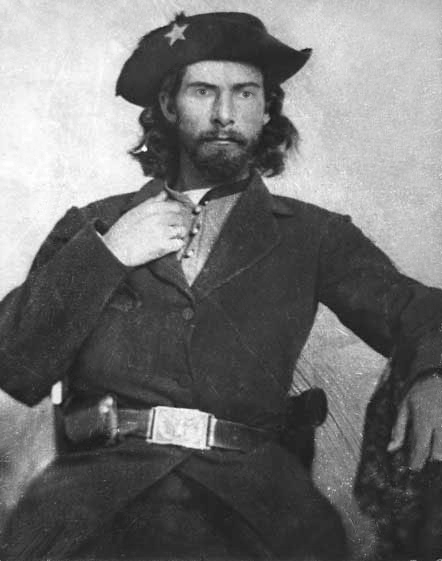William T. Anderson
 William T. Anderson (c. 1840October 26, 1864), known by the nickname "Bloody Bill" Anderson, was a soldier who was one of the deadliest and most notorious Confederate guerrilla leaders in the American Civil War. Anderson led a band of volunteer partisan raiders who targeted Union loyalists and federal soldiers in the states of Missouri and Kansas.
William T. Anderson (c. 1840October 26, 1864), known by the nickname "Bloody Bill" Anderson, was a soldier who was one of the deadliest and most notorious Confederate guerrilla leaders in the American Civil War. Anderson led a band of volunteer partisan raiders who targeted Union loyalists and federal soldiers in the states of Missouri and Kansas. Raised by a family of Southerners in Kansas, Anderson began to support himself by stealing and selling horses in 1862. After a former friend and secessionist turned Union loyalist judge killed his father, Anderson killed the judge and fled to Missouri. There he robbed travelers and killed several Union soldiers. In early 1863 he joined Quantrill's Raiders, a group of Confederate guerrillas which operated along the Kansas–Missouri border. He became a skilled bushwhacker, earning the trust of the group's leaders, William Quantrill and George M. Todd. Anderson's bushwhacking marked him as a dangerous man and eventually led the Union to imprison his sisters. After a building collapse in the makeshift jail in Kansas City, Missouri killed one sister, and left another permanently maimed, Anderson devoted himself to revenge. He took a leading role in the Lawrence Massacre and later took part in the Battle of Baxter Springs, both in 1863.
In late 1863, while Quantrill's Raiders spent the winter in Sherman, Texas, animosity developed between Anderson and Quantrill. Anderson, perhaps falsely, implicated Quantrill in a murder, leading to the latter's arrest by Confederate authorities. Anderson subsequently returned to Missouri as the leader of his own group of raiders and became the most feared guerrilla in the state, robbing and killing a large number of Union soldiers and civilian sympathizers. Although Union supporters viewed him as incorrigibly evil, Confederate supporters in Missouri saw his actions as justifiable. In September 1864, Anderson led a raid on the town of Centralia, Missouri. Unexpectedly, his men were able to capture a passenger train, the first time Confederate guerrillas had done so. In what became known as the Centralia Massacre, Anderson's bushwhackers killed 24 unarmed Union soldiers on the train and set an ambush later that day which killed over a hundred Union soldiers. Anderson himself was killed a month later in battle. Historians have made disparate appraisals of Anderson; some see him as a sadistic, psychopathic killer, while others put his actions into the perspective of the general desperation and lawlessness of the time and the brutalization effect of war. Provided by Wikipedia
-
1
-
2
-
3
-
4
-
5
-
6
-
7
-
8
-
9
-
10
-
11by Pawel Kudela, Pawel Kudela, Dana Boatman-Reich, Dana Boatman-Reich, David Beeman, William Stanley Anderson, William Stanley AndersonGet full text
Published 2018-09-01
Article -
12
-
13
-
14
-
15
-
16
-
17
-
18
-
19
-
20
